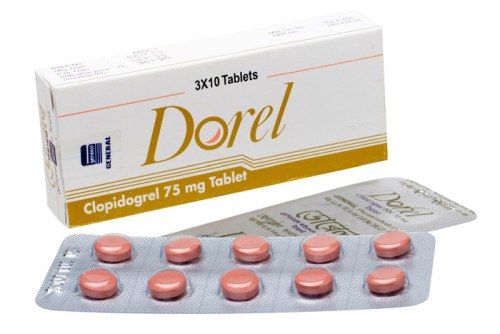
Type:10 Tablets
Generic Name:Clopidogrel
Manufacturer:General Pharmaceuticals Ltd.
Price:৳115.00
Coronary Artery Disease, Acute coronary syndrome, Myocardial infarction, Peripheral vascular disease, Cerebrovascular disease, Atherosclerosis, Thromboembolic disorders, Unstable angina, Stroke
May be taken with or without food.
Oral Prophylaxis of thromboembolic disorders, Recent MI, Stroke, or Established Peripheral Arterial Disease, Coronary Artery Disease Adult: 75 mg once daily. Acute coronary syndrome Adult: For ST-elevation MI: In combination w/ aspirin: 75 mg once daily. <75 years 300 mg loading dose followed by 75 mg for 14 days up to 12 months (if no bleeding) Concomitant therapy with aspirin: Administer in combination with aspirin 75-325 mg qDay with or without thrombolytics >75 years No loading dose 75 mg for 14 days up to 12 months (if no bleeding) For unstable angina, non-ST-elevation MI: In combination w/ aspirin: Initially, 300 mg loading dose, followed by 75 mg once daily for up to 12 mth. Hepatic impairment: Use caution; experience limited
Renal impairment: Dose adjustment not necessary
Hypersensitivity. Active pathological bleeding. admin within 7 days after MI and ischaemic stroke, coagulation disorders. Lactation.
Clopidogrel inhibits adenosine diphosphate (ADP) from binding to its receptor sites on the platelets and subsequent activation of glycoprotein GP IIb/IIIa complex thus preventing fibrinogen binding, platelet adhesion and aggregation.
Patients at risk of increased bleeding from trauma, surgery, or other pathological conditions; ulcer; renal and hepatic impairment; history of bleeding or haemostatic disorders. Pregnancy. Lactation: Not known whether drug is excreted in breast milk; not recommended
1-10% Upper respiratory tract infection (8.7%),Chest pain (8.3%),Headache (7.6%),Flulike syndrome (7.5%),Arthralgia (6%),Pain (6%),Dizziness (6%),Diarrhea (4.5%),Rash (4.2%),Rhinitis (4.2%),Depression (3.6%),Urinary tract infection (3.1%) <1% Severe neutropenia,Thrombotic thrombocytopenic purpura,Acute liver failure,Aplastic anemia,Hypotension,Hepatitis,Myalgia,Eczema,Erythema,Agranulocytosis Potentially Fatal: Bleeding disorders including GI and intracranial haemorrhage. Blood dyscrasias.
Pregnancy Available data from cases reported over two decades in published literature and postmarketing surveillance have not identified any drug-associated risks for major birth defects or miscarriage; there are risks to pregnant woman and fetus associated with myocardial infarction and stroke Myocardial infarction and stroke are medical emergencies; therapy for pregnant woman should not be withheld because of potential concerns regarding effects of clopidogrel on the fetus Labor or delivery Therapy during labor or delivery will increase risk of maternal bleeding and hemorrhage; avoid neuraxial blockade during clopidogrel use because of risk of spinal hematoma; when possible, discontinue therapy 5-7 days prior to labor, delivery, or neuraxial blockade There are no data on presence of drug in human milk or effects on milk production; no adverse effects on breastfed infants observed during lactation in a small number of postmarketing cases; studies in rats have shown that clopidogrel and/or its metabolites are present in milk; when a drug is present in animal milk, it is likely that the drug will be present in human milk; consider developmental and health benefits of breastfeeding along with mother’s clinical need for therapy and any potential adverse effects on breastfed infant from drug or underlying maternal condition
Co-admin with NSAIDs may increase the risk of stomach and intestinal bleeding. High-dose clopidogrel may lead to increased warfarin levels thus increasing the risk of bleeding. High-dose clopidogrel may also inhibit P450 (2C9), thus interfering with the metabolism of phenytoin, tamoxifen, torasemide, fluvastatin and some NSAIDs. Avoid c